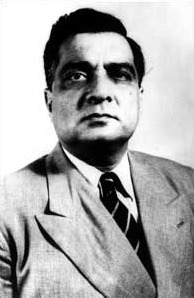Most of the threads I see are posted from media like websites and newspapers. Most pieces of news are factual, other than maybe speculations on defence purchases.
Like Muhammad Ali said, you can't call it bragging, if you can back it up...
On topic - here is more reading,
The 1st president of Pakistan was a Sandhurst-trained Bengali, Iskander Mirza, from the Nawab Family of Bengal,
https://en.wikipedia.org/wiki/Iskander_Mirza
Iskander Mirza as
2nd-Lt in the
British Indian Army,
ca.1920
Official portrait
https://en.wikipedia.org/wiki/Pakistan_Movement#Bengal
https://en.wikipedia.org/wiki/Khabeeruddin_Ahmed
https://en.wikipedia.org/wiki/Abdul_Halim_Ghaznavi
https://en.wikipedia.org/wiki/Huseyn_Shaheed_Suhrawardy
https://en.wikipedia.org/wiki/Khawaja_Nazimuddin
https://en.wikipedia.org/wiki/Mohammad_Ali_Bogra
https://en.wikipedia.org/wiki/Abul_Mansur_Ahmed
Abul Mansur Ahmed's Grandfather was the founder of the Faraizi Movement in East Bengal in 1819, Which was a British non-cooperation movement, that was a pre-cursor for the Two nation theory. In this instance too - Bengal was a hundred years ahead of the rest of the Indian subcontinent, in search of self determination. Quaid-e-Azam Jinnah was not to be born until thirty years later.
https://en.wikipedia.org/wiki/A._K._Fazlul_Huq
It may be mentioned here, that the
Lahore Resolution was presented by
A. K. Fazlul Huq (himself from Bengal), which was a formal political statement adopted by the
All-India Muslim League on the occasion of its three-day general session in
Lahore on 22–24 March 1940. The resolution called for independent states as seen by the statement:
"That geographically contiguous units are demarcated regions which should be constituted, with such territorial readjustments as may be necessary that the areas in which the Muslims are numerically in a majority as in the North Western and Eastern Zones of (British) India should be grouped to constitute ‘independent states’ in which the constituent units should be autonomous and sovereign."
Although the name "Pakistan" had been proposed by
Choudhary Rahmat Ali in his
Pakistan Declaration,
[4] it was not until after the resolution that it began to be widely used.
By the way - President of Indian National Congress, Maulana Abul Kalam Azad, also had Bengali ancestry.
The AIME Conference in 1906, held at the Ahsan Manzil palace of the Dhaka Nawab Family, laid the foundation of the Muslim League.










 on this thread again
on this thread again